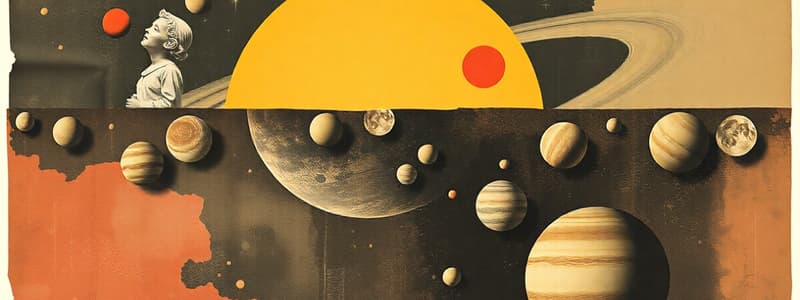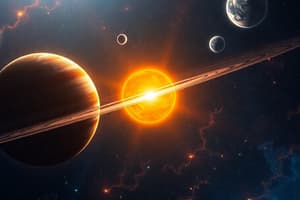Podcast
Questions and Answers
What is the approximate distance of 1 AU in kilometers?
What is the approximate distance of 1 AU in kilometers?
About 150 million km.
Name two characteristics that define inner planets.
Name two characteristics that define inner planets.
They are mostly made of rock and metal and tend to have few moons.
What significant change occurred to Pluto in 2006?
What significant change occurred to Pluto in 2006?
Pluto's planetary status was revoked by the International Astronomical Union.
How does the mass of the Sun compare to the rest of the solar system?
How does the mass of the Sun compare to the rest of the solar system?
Describe the main component of the outer planets' composition.
Describe the main component of the outer planets' composition.
What is one major physical characteristic of Earth?
What is one major physical characteristic of Earth?
What is the circumferential measurement of Earth at the equator?
What is the circumferential measurement of Earth at the equator?
List two differences between inner and outer planets.
List two differences between inner and outer planets.
Where is our Solar System located within the galaxy?
Where is our Solar System located within the galaxy?
What distinguishes the rotational speeds of inner planets compared to outer planets?
What distinguishes the rotational speeds of inner planets compared to outer planets?
Flashcards
Solar System
Solar System
The Sun and all the objects that orbit it, including planets, moons, asteroids, and comets.
Astronomical Unit (AU)
Astronomical Unit (AU)
The average distance from Earth to the Sun, roughly 150 million kilometers.
Inner planets
Inner planets
Rocky planets closer to the Sun. (like Earth)
Outer planets
Outer planets
Signup and view all the flashcards
Earth's Shape
Earth's Shape
Signup and view all the flashcards
Earth's mean radius
Earth's mean radius
Signup and view all the flashcards
Milky Way
Milky Way
Signup and view all the flashcards
Galaxy
Galaxy
Signup and view all the flashcards
Planet
Planet
Signup and view all the flashcards
Pluto's status
Pluto's status
Signup and view all the flashcards
Study Notes
Our Solar System
- Composed of the Sun and objects orbiting it (planets, moons, asteroids, etc.).
- Located in the Milky Way galaxy, near the outer edge.
- The Milky Way is a large, disc-shaped galaxy with stars held together gravitationally.
- Stars have differing sizes, shapes, and densities.
- The Sun accounts for 99.9% of the Solar System's mass.
- One Astronomical Unit (AU) is the average distance from Earth to the Sun (approximately 150 million km).
Planets
- Spherical objects orbiting the Sun.
- All planets spin on their axes.
- Eight planets in the Solar System, classified as:
- Inner planets (also called terrestrial planets):
- Primarily composed of rock and metal
- Smaller
- Few or no rings
- Tend to spin slower on their axes
- Examples: Mercury, Venus, Earth, Mars
- Outer planets (also called Jovian planets or gas giants):
- Primarily composed of hydrogen and helium
- Larger
- Ring systems
- Many moons
- Examples: Jupiter, Saturn, Uranus, Neptune
- Inner planets (also called terrestrial planets):
Pluto
- Discovered in 1930.
- Reclassified as a dwarf planet in 2006 by the International Astronomical Union.
- Does not have moons.
Earth
- Shape: A spheroid (slightly flattened sphere)
- Mean radius: 6371 km
- Circumference at the equator: 40,075 km
Studying That Suits You
Use AI to generate personalized quizzes and flashcards to suit your learning preferences.




